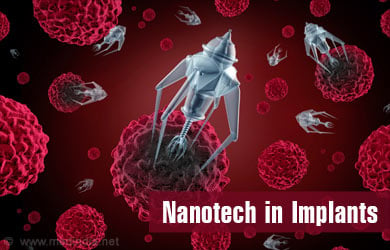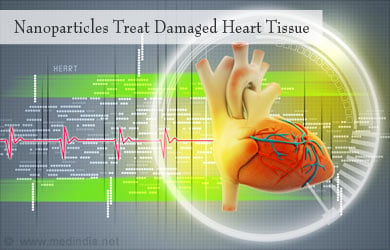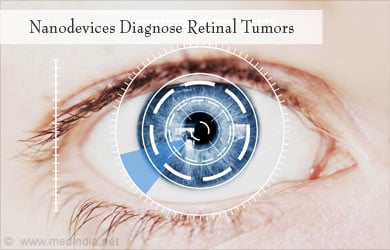- Could nanotechnology improve treatment of heart attack and heart failure? - (http://vector.childrenshospital.org/2011/09/could-nanotechnology-improve-treatment-of-heart-attack-and-heart-failure/)
- Nanotechnology holds promise for safer breast implants - (http://phys.org/news/2011-10-nanotechnology-safer-breast-implants.html)
- Injectable brain implant spies on individual neurons. Nature.2015; 522. 137
- NanoTechnology - (http://www.nano.gov/nanotech-101/what/definition)
- Brain implant - (https://en.wikipedia.org/wiki/brain_implant)
- What is Nanotechnology? - (http://www.crnano.org/whatis.htm)
- Lavenus S, Louarn G, Layrolle P. Nanotechnology and Dental Implants. International Journal of Biomaterials. 2010, 1-9.
- Parchi et al., How Nanotechnology can Really Improve the Future of Orthopedic Implants and Scaffolds for Bone and Cartilage Defects. J Nanomedicine Biotherapeutic Discov 2013, 3:2
- Nair A, Thevenot P, Hu W, Tang L. Nanotechnology In The Treatment And Detection Of Intraocular Cancers. J Biomed Nanotechnol. 2008 Dec 1; 4(4): 410-418.
What are the Applications of Nanotechnology in Medicine?
'When a lot of remedies are suggested for a disease, that means it cannot be cured.'- Anton Chekov
Nanotechnology today finds its application in all fields of science, be it physics, chemistry, biology, engineering and material science.
Enormous potential prevails in healthcare as well, right from drug delivery, diagnosing disease, delivering vaccines by aerosols and patches, and even use of intelligent medical implants for heart, tissues and bones, hips, eyes, etc.

Nanotechnology in Brain Implants
Nanotechnology provides several potential solutions to brain diseases. For example, an implant made of a silky mesh studded with tiny electronic devices has the potential to be used in conditions like Parkinson’s disease. When the mesh was implanted into the mouse brain, it was found to unfurl to spy on and stimulate individual nerve cells.
Nanotechnology in Heart Disease
Heart attack or heart failure often damages and weakens the heart muscle. By using nanotechnology, scientists at Children’s Hospital Boston and MIT have found innovative methods which could possibly be used to strengthen the weakened and scarred heart tissue. One of them is the use of minute nanoparticles that carry stem cells, growth factors, drugs and other therapeutic compounds to the damaged muscle. These nanoparticles or guided missiles secrete medicine at slow rate, and help in treating the damaged heart tissue. Another method is the use of implants that are laced with gold and contain cardiac cells. Such an implant could help the heart to beat normally.

Nanotechnology for Breast Implants
Nanotechnology holds promise for having safer breast implants. A review published in WIREs Nanomedicine and Nanobiotechnology says that safer breast implants using nanotechnology could be an alternative to silicone in the future thereby minimizing complications due to the silicone implants like systemic diseases, cancer and psychological disease. Such implants may also be able to deliver cancer drugs locally, thus improving treatment efficacy and reducing side effects linked with chemotherapy.
Nanotechnology for Dental Implants
In dental surgery, implants are commonly used for restoring teeth. It is important that the implant remains stable in position for the procedure to be successful. Using nanotechnology, the implant surface may be modified so that it integrates with the gum tissue and remains fixed. For example, coatings of bioactive calcium phosphate nanocrystals can be applied to the dental implant.
Nanotechnology for Orthopedic Implants
Orthopedic limb implants have helped patients regain their independence. However, in some cases, the implant surgery fails, often due to insufficient tissue growth around the implant. Nanomaterials have been found to support tissue and bone growth, and reduce chances of infection and scar tissue formation, thereby probably increasing the chances of implant success. Nanophase ceramics, particularly nano-hydroxyapatite, are popular as bone substitutes, coatings and other filler materials since they promote the functions of bone-forming cells called osteoblasts.
Nanotechnology for Ocular Implants
Nanodevices have been used in the eye for the local delivery of drugs. They are made of polymeric or biological materials. They remain in the eye for a long time and usually cause a minimal reaction. Nanodevices may also be useful in diagnosis of diseases of the retina, including tumors.
With its rapid progress, nanotechnology has been found useful in several incurable diseases. However, further research is needed to address issues that currently limit its usefulness.






